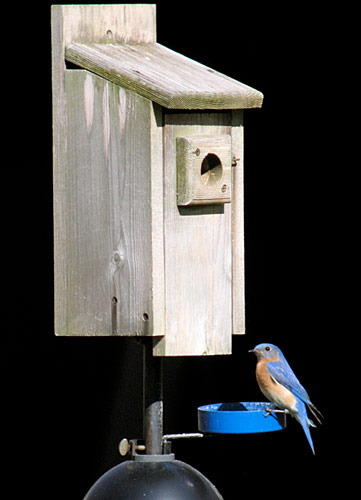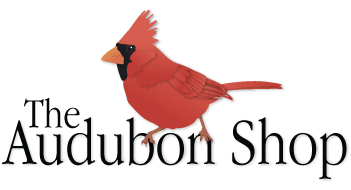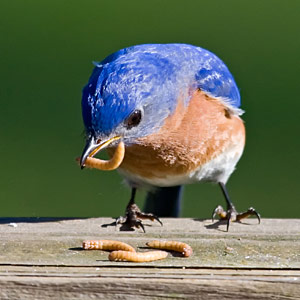Entice Eastern Bluebirds with Mealworms
I have an early morning ritual most days in spring and summer. Pour a cup of “joe” (quick sip) and head out to pick up the morning paper. On my way out of the garage, I grab the cup of meal worms. I pucker up and perform my weak imitation of an Eastern Bluebird’s sweet whistle. Halfway down the driveway, I pause to pour a few dozen of the worms into the blue metal dish that is affixed to the pole below the nest box. By the time I have the newspaper in hand, both the male and the female are on the cup stuffing their beaks with the live offerings. One at a time they enter the box to feed the hungry “quintuplets.” This year’s pair is probably “new to the neighborhood,” since it took some time to “train” them.

A glass Mealworm Feeder supported by a sturdy, heavy duty wire hanger can hang near your Bluebird Nesting Box.
In terms of beauty and tameness, the Eastern Bluebird (Sialis sialis) has few rivals. During the first three quarters of the last century, their numbers greatly declined, due to the loss of open-field habitat and the ill-advised introduction of the House Sparrow (1851) and the European Starling (1890), both formidable nest competitors. Today, because of pro-active human landlords providing and monitoring nest boxes, the comeback of the Eastern Bluebird is nothing short of remarkable. As recently as the late 1980s, it has been possible for one person alone to monitor all known bluebird nests in the towns of Clinton, Killingworth, Madison, Guilford, and Branford! Today, hundreds of our customers are successful bluebird landlords.
Last year, a single pair of bluebirds fledged 3 broods (five, five, and four young) in the same box situated in our North Madison front yard! In addition to providing a safe nest box, essential for bluebird nest success, one may reasonably attribute the exceptional number of broods/young to our mealworm “supplements.”
Bluebirds begin to nest in early- to mid-April, when the weather can still be wet and cold, and have two to three broods. Typically they lay 4 to 5 eggs (one per day), but the oft-adverse weather conditions can make it difficult for bluebirds to earn a living, hawking insects from the lawn. Consequently, it’s unusual for a pair to fledge a full brood in April. That’s where the mealworms come in. Mealworms are not really worms at all, but are the larval form of the Darkling Beetle (Tenebrio molitor). They are clean (dry), do not carry human diseases, and most importantly are a nutritious food supplement readily accepted by bluebirds. Having sold mealworms for years, we’ve seen their popularity take off, especially with the Eastern Bluebird aficionados.

Male Eastern Bluebird perched below his bluebird houseMale Eastern Bluebird perched below his bluebird house
Many other birds may be interested as well, so it’s important to train your birds so that they have first dibs. Assuming you already have a nest box up (if not, what are you waiting for?), place your mealworm feeder near the nest box. The feeder can be as simple as a bowl or pie tin, though we use a $10 Bluebird Feeder, a blue metal cup/clamp assembly that affixes conveniently to our nest box pole. Once birds are either checking out or nesting in your box, offer just enough worms for the bird(s) to eat before others take notice. Whistle or talk softly to the birds before making your offering. They will learn to come for mealworms in response to your whistle or voice, a bell, or even a garage door opener. What I do is offer forty or fifty worms twice a day (morning/evening) after there are young in the nest. The worms we provide constitute only a portion of the birds’ total diet. The offering vanishes in a couple of minutes, but attentive bluebird parents continue to feed captured prey to the nestlings throughout the day. Time to rethink the phrase, “Eats like a bird”!
I’d like to believe that we’re reducing the parents’ stress of raising so many young. With the energy savings, the adults may start the next brood sooner! It is one of our great joys to see the young from previous broods, visiting the little blue feeder on their own. Hopefully by summer’s end, our yard will once again be filled with “cerulean jewels.”

